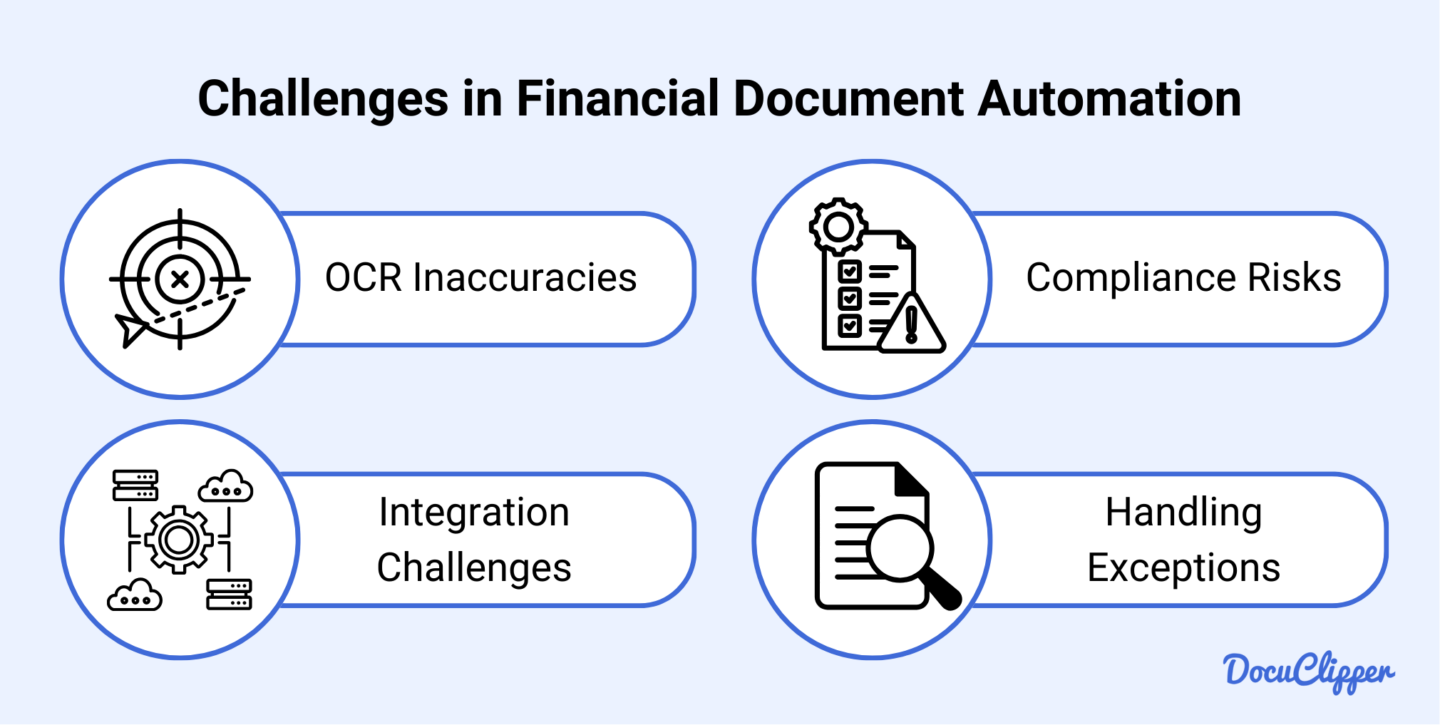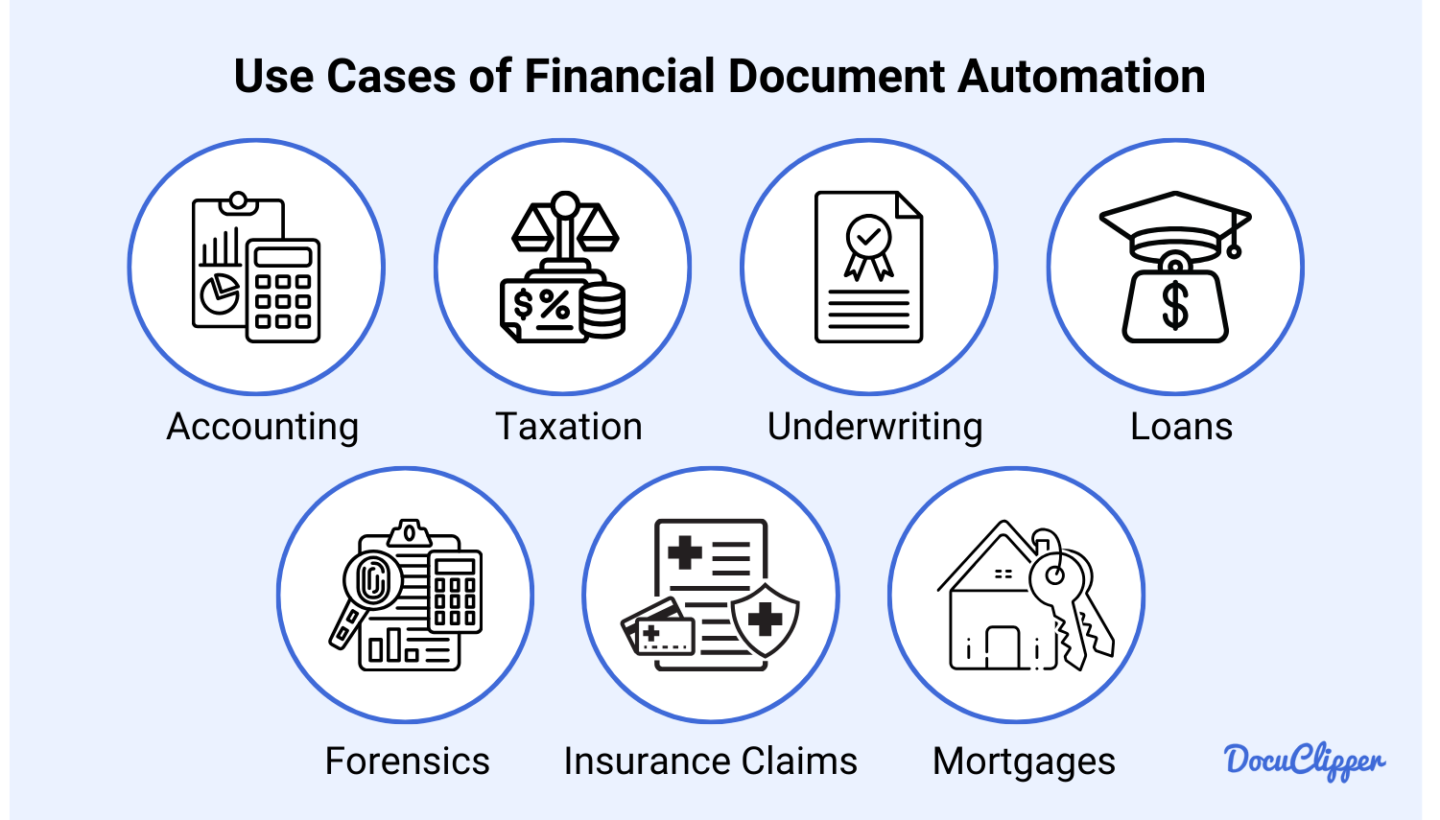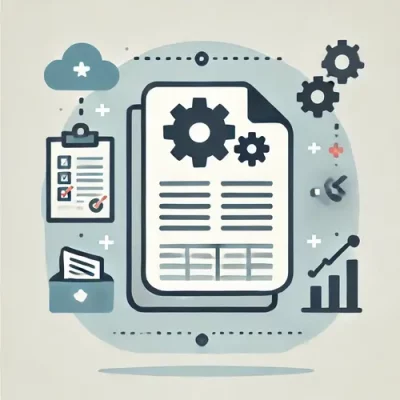Key Takeaways:
- Financial document automation eliminates manual data entry, reducing human error, improving compliance, and enhancing accuracy in bookkeeping and financial reporting.
- Businesses that implement automation experience a 30% reduction in processing time, leading to higher efficiency and increased profitability.
- Challenges include OCR inaccuracies and integration complexities, which require high-accuracy extraction tools and seamless system compatibility to mitigate risks.
- Financial document automation is widely used in industries like accounting, taxation, underwriting, and insurance, streamlining processes and improving operational efficiency.
- Automating financial document processing can reduce costs by up to 80%, significantly lowering operational expenses compared to manual data handling.
What is Financial Document Automation?
Financial document automation helps you streamline the creation, management, processing and distribution of financial records such as invoices, bank statements, and contracts.
This technology uses OCR data extraction, natural language processing (NLP), and machine learning to extract relevant details from scanned or digital documents with minimal human intervention.
By automating document processing, you can eliminate manual data entry, reduce errors, and enhance compliance with financial regulations.
AI-powered automation categorizes financial data, populates templates, and even applies business rules to optimize your workflows. This not only accelerates document handling but also ensures accuracy across accounting, bookkeeping, and financial reporting.
With automation, financial institutions and businesses can improve operational efficiency, minimize errors, and maintain regulatory compliance. all while freeing up valuable time for more strategic tasks.
What is Financial Document Automation Software?
Financial document automation software automates the extraction, classification, and processing of financial data from various documents.
It uses Optical Character Recognition (OCR) to scan and retrieve text from financial documents, Intelligent Document Processing (IDP) to categorize and validate data, and parsing algorithms to structure information for seamless integration.
By leveraging these technologies, the software captures financial details from receipts, invoices, purchase orders, and bank statements while integrating directly with accounting platforms.
This ensures efficient bank statement processing, invoice processing, and automates your bookkeeping, significantly reducing manual effort and improving accuracy.
10 Benefits of Financial Document Automation
Automating financial documents comes with numerous advantages that enhance efficiency and accuracy. Here are ten key benefits you can expect:
- Increased Productivity & Profitability: Businesses that implement financial document automation see a 30% reduction in processing time, leading to higher productivity and profitability.
- Version Control & Consistency: Ensures that your financial documents are standardized, eliminating errors caused by outdated or mismatched data.
- Improved Compliance & Auditability: Companies using automation have increased their compliance rates by 35% compared to manual tracking methods, reducing regulatory risks and audit complexities
- Cost Savings: Automating document processing for invoices can reduce costs from up to $16 per invoice with manual entry to as little as $3 per invoice.
- Enhanced Customer Experience: Faster processing times for invoices, receipts, and transactions lead to improved vendor and customer relationships.
- Eliminates Manual Data Entry: OCR data capture automates data extraction, so you no longer need to copy and paste information manually.
- Reduces Duplicate or Unnecessary Work: Prevents redundant processing by ensuring that each document is processed once and stored efficiently.
- Speeds Up Personalization & Customization: Automates financial document templates for customized reports, contracts, and agreements.
- Enables Rapid Document Creation: Allows you to generate entire document packages automatically without manual intervention.
- Keeps Documents Up to Date: Ensures that all financial records reflect the latest terms, policies, and legal requirements.
Challenges in Financial Document Automation

While automation enhances efficiency, it also comes with challenges that can affect implementation and accuracy. You may encounter issues related to data quality, system compatibility, and regulatory compliance. Understanding these challenges can help you mitigate risks and optimize your financial document automation strategy.
- OCR Inaccuracies: Low-quality scans, handwritten text, or inconsistent formatting can lead to errors in invoice data extraction.
- Integration Challenges: Legacy systems and outdated accounting software may require complex API configurations for automation.
- Compliance Risks: Ensuring compliance with GDPR, SOX, and financial security standards requires strict encryption and access controls.
- Handling Exceptions: Non-standard financial documents may require manual intervention when automation tools cannot process them correctly.
Use Cases of Financial Document Automation

Financial document automation streamlines various tasks across industries, improving efficiency and accuracy. Whether you’re managing financial records, handling compliance, or processing transactions, automation can significantly reduce manual effort and errors. Here’s how you can apply it:
- Accounting and Bookkeeping: Automates transaction categorization and eliminates manual data entry in financial statements.
- Taxation and Compliance: Ensures accurate tax filings and audits by extracting financial data from structured and unstructured documents.
- Underwriting: Speeds up loan approvals by processing bank statements and verifying applicant financial history.
- Loans: Automates document review for faster loan application processing and decision-making.
- Forensics: Enhances forensic accounting by analyzing financial records and identifying fraudulent activities.
- Insurance Claims: Simplifies claim verification by extracting key details from receipts and financial reports.
- Mortgage and Financing: Automates mortgage approval processes by streamlining document data extraction and verification.
How to Implement Financial Document Automation Software in Your Process
Implementing financial document automation requires a structured approach to ensure seamless integration and efficiency. Follow these steps to successfully adopt automation in your workflow:
- Assess Your Needs: Identify inefficiencies in your financial document workflow and determine which document types require automation. Understanding these pain points will help you choose the right features and ensure a smoother transition.
- Choose the Right Software: Select a solution that provides high OCR accuracy, automated invoice processing, and purchase order automation. Ensuring the software aligns with your business needs will maximize efficiency and minimize errors.
- Integrate with Existing Systems: Connect the software with your current accounting platforms, such as QuickBooks, Xero, ERPs, and cloud storage. Proper integration eliminates manual data entry, reduces duplication, and streamlines financial processes.
- Configure Workflow Automation: Set up automation rules for data validation, approvals, and exception handling. Customizing workflows ensures documents are processed efficiently while maintaining compliance and accuracy.
- Train Your Team: Provide user training to ensure employees can effectively use the software and maximize its benefits. A well-trained team adapts faster to automation, reducing errors and improving overall workflow efficiency.
- Monitor and Optimize: Continuously track system performance to identify areas for improvement and resolve any issues. Regular optimization helps maintain accuracy, efficiency, and compliance as your automation processes evolve.
Criteria for Choosing a Financial Document Automation Software
Selecting the right financial document automation software is essential for maximizing efficiency and accuracy. Consider these key factors when making your decision:
- Accuracy & OCR Capabilities: The software should have high OCR data extraction accuracy to ensure precise financial data processing. Poor accuracy can lead to errors in bookkeeping, tax reporting, and compliance documentation.
- Integration with Existing Systems: A seamless connection with accounting platforms like QuickBooks and Xero enables smooth data flow. Without proper integration, you may face inefficiencies and data inconsistencies.
- Security & Compliance: The software must meet GDPR, SOX, and financial security standards to protect sensitive data. Strong encryption and access controls help prevent unauthorized access and potential breaches.
- Customization & Workflow Automation: The ability to configure document workflows, approval processes, and custom rules is crucial. This ensures that automation aligns with your company’s specific financial operations.
- Scalability & Performance: The software should efficiently handle increasing document volumes without lagging. A scalable solution ensures that your automation remains effective as your business grows.
- User-Friendliness: A simple and intuitive interface allows for easy adoption by your finance team. Complicated software with a steep learning curve can slow down implementation and reduce productivity.
- Cost-Effectiveness & ROI: The software should provide measurable time and cost savings compared to manual document processing. A solution that reduces labor costs while increasing accuracy and efficiency will yield a higher return on investment.
How DocuClipper Can Help with Financial Document Automation
Manually processing financial documents is time-consuming, error-prone, and inefficient. Entering transaction data from bank statements, invoices, and receipts can lead to mistakes, compliance risks, and unnecessary operational costs.
Without automation, your accounting workflows remain slow, increasing the chance of data inconsistencies and audit issues.
DocuClipper eliminates these challenges by automating bank statement processing, invoice data extraction, and transaction categorization.
It seamlessly integrates with QuickBooks, Xero, and other accounting platforms, ensuring accurate OCR data capture without manual entry. With AI-powered automation, you can extract line items, detect inconsistencies, and streamline bookkeeping—giving you faster, more reliable financial workflow.
FAQs about Financial Document Automation
Here are some frequently asked questions about financial document automation:
Can financial reporting be automated?
Yes, financial automation software can generate reports by extracting, processing, and categorizing financial data from various documents. It eliminates manual data entry, reduces errors, and ensures compliance with financial regulations. By integrating with accounting software, automation tools streamline reporting, providing accurate insights for decision-making while saving time and operational costs.
What are the 4 types of financial documents?
The four main types of financial documents are bank statements, invoices, receipts, and tax forms. These documents are essential for tracking transactions, managing expenses, and ensuring compliance. With financial document automation, you can extract, process, and categorize data from these documents efficiently, reducing manual work and minimizing errors in financial reporting.
What is finance automation?
Finance automation refers to the use of technology to streamline financial processes such as document processing, transaction categorization, and reporting. It eliminates manual data entry by leveraging OCR, AI, and workflow automation, improving accuracy and efficiency. Businesses use finance automation to reduce errors, save time, and ensure compliance with financial regulations.
What is an example of document automation?
An example of document automation is automated invoice processing, where OCR extracts data from invoices, categorizes transactions, and syncs them with accounting software like QuickBooks or Xero. This eliminates manual data entry, reduces errors, and accelerates approvals, allowing businesses to streamline their financial workflows and improve efficiency.
How to automate financial statements in Excel?
You can automate financial statements in Excel by using OCR data extraction tools to pull transaction data from bank statements, invoices, and receipts. Integrating Excel with accounting OCR software or financial automation tools allows for real-time data updates, reducing manual entry.
Is QuickBooks an automated financial system?
QuickBooks includes automation features like transaction categorization, invoice processing, and bank reconciliation, reducing manual effort. However, for full automation, you need third-party integrations with tools like DocuClipper for OCR data extraction and automated bookkeeping. These integrations enhance data accuracy, streamline workflows, and eliminate manual data entry.
How to automate accounting bookkeeping?
You can automate bookkeeping by using OCR-powered financial document automation software to extract and process data from invoices, receipts, and bank statements. These tools integrate with accounting platforms like QuickBooks and Xero, categorizing transactions and reducing manual data entry. Automation improves accuracy, saves time, and ensures seamless financial record-keeping.



